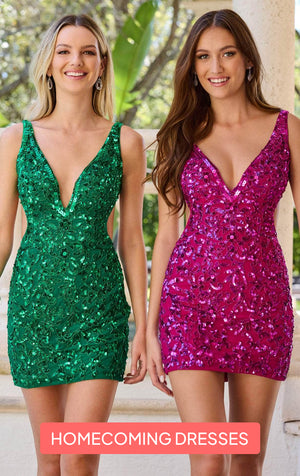Spring - The season of sunny weather, blooming flowers, beautiful sky, and colorful spring weddings! Did you get an invitation already? As the invitations for this spring wedding start, the question may arise in your mind: what should I wear? Well, don’t worry! We are here to solve your puzzle....
-
Prom 2024
All Prom
Prom By Style
Prom By Color
- Black Prom Dresses
- Red Prom Dresses
- Green Prom Dresses
- White Prom dresses
- Pastel Prom Dresses
- Mauve Prom Dresses
- Blue Prom Dresses
- Pink Prom Dresses
- Orange Prom Dresses
- Yellow Prom Dresses
- Gold Prom Dresses
- Silver Prom Dresses
- Purple Prom Dresses
- Lavender Prom Dresses
- Champagne Prom Dresses
- Burgundy Prom Dresses
- Formal
-
Homecoming
All Homecoming
Homecoming By Style
Homecoming By Color
- Blue Homecoming Dresses
- Pink Homecoming Dresses
- White Homecoming Dresses
- Black Homecoming Dresses
- Red Homecoming Dresses
- Purple Homecoming Dresses
- Lavender Homecoming Dresses
- Green Homecoming Dresses
- Orange Homecoming Dresses
- Yellow Homecoming Dresses
- Gold Homecoming Dresses
- Silver Homecoming Dresses
- Champagne Homecoming Dresses
-
Quinceanera
- All Quinceañera Dresses
- Blue Quinceanera Dresses
- Pink Quinceanera Dresses
- Black Quinceanera Dresses
- White Quinceanera Dresses
- Red Quinceanera Dresses
- Purple Quinceanera Dresses
- Lavender Quinceanera Dresses
- Green Quinceanera Dresses
- Orange Quinceanera Dresses
- Yellow Quinceanera Dresses
- Champagne Quinceanera Dresses
- Gold Quinceanera Dresses
- Silver Quinceanera Dresses
- Cheap Quinceanera Dresses
- Long Sleeve Quinceanera Dresses
-
Occasions
All Events
- Ball Gowns Dresses
- Birthday Dresses
- Black Tie Dresses
- Formal Dance Dresses
- Graduation Dresses
- Holiday Dresses
- Prom Dresses
- Military Ball Dresses
- Pageant Dresses
- Quinceanera Dresses
- Sweet 16 Dresses
- Cruise Dresses
- Family Celebration Dresses
- Rehearsal Dinner Dresses
- Dating Dresses
- Bar Mitzvah Dresses
- Junior Prom Dresses
- White Graduation Dresses
-
Styles
All Style
- Mini Dresses
- Ruched Dresses
- Strapless Dresses
- Semi Formal Dresses
- Trumpet Dresses
- Babydoll Dresses
- Classic Prom Dresses
- A-Line Dresses
- Bows Dresses
- Halter Dresses
- Sweetheart Dresses
- Sexy and Sleek Dresses
- One Shoulder Dresses
- Illusion Dresses
- Evening Gowns Dresses
- Low V-Neck Dresses
- Ball Gowns Dresses
- Corset Dresses
- Little Black Dresses
- Fit & Flare Dresses
- Mermaid Dresses
- Open Back Dresses
- Sleeveless Dresses
- Bodycon Dresses
- Two Piece Dresses
- Cut Out Dresses
- Formal Pantsuits Dresses
- Little White Dresses
- Midi Dresses
- Pleated Dresses
- Sleeves Dresses
- V-Neck Dresses
- Backless Dresses
- Long Black Dresses
- Empire Waist Dresses
New Collection
Fabric
- Colors
- Plus Size
-
Sale
Dresses On Sale
- All Dresses On Sale
- Formal Gowns On Sale
- Cocktail Dresses On Sale
- Mother of the Bride On Sale
- Bridesmaid Dresses On Sale
- Prom Dresses On Sale
- Plus Size Dresses On Sale
- Homecoming Dresses On Sale
- Long Dresses On Sale
- Short Dresses On Sale
- Party Dresses On Sale
- Quinceanera Dresses On Sale
- Ball Gowns On Sale
-
DESIGNERS
A-F
G-L
M-Q


























 Twitter
Twitter














